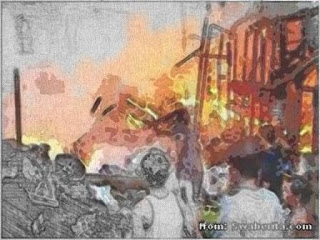A few months ago people were surprised on realizing that a "crazy" young man has burnt down dozens of trains at Rangkasbitung. The incident happened because the train officials were not alert to guard the station, nor did they pay attention to the intruders sleeping inside the train. The result was serious. Many trains were unable to operate, the damaged trains had to be repaired and, the total loss was up to billions of rupiah.
The similar incident happened again in Jayakarta Station on January 6, 2011, but this time the fire which was suspected caused by electric short circuit burnt down 30 kiosks illegally installed under the railway fly-over connecting City (Kota) Station to Manggarai.
The KAI officials quickly announced that KAI did not suffer from any significant damage but communication cables. As a result, scores of train schedules were beyond controlled, causing thousands of passengers stranded in many stations. But those are only the losses which are noticeable, excluded the possibility of the weakening of the structure of concrete block by the fire which might shorten the life-span of the fly-over.
Now a big question arises! Who allows those people to build their kiosks under the fly-over, upon which the double track rails were constructed? As stated in the law related to train and its railways, the space above and below the fly-over must be free from any building and public activities.
Based on the law, all the kiosks constructed below the fly-over are illegal. But so far the owners have worked and operated freely without caring about the public complaints. Some KAI officials said they could not understand why the kiosks were constructed there though forbidden by the law. So, then, who is responsible for this mess? Are they KAI management, Ministry of Transportation and Communication or city government?
We must also remember that many illegal shelters have been built nearby the railway tracts. And worse come worse as there are informal markets in operation right within the tracts close by the Djuanda, Jayakarta and Cawang stations, just to mention a few.
There was planning that the KAI management in cooperation with City Government will clear up the shelters along the railway tracts. It is hoped that the plan will be seriously executed.
Logically the presence of the kiosks, shelters and informal markets under the fly-over, nearby or right within the railway tracts must have the blessing from the officials. But when the fire razed the area no one dared to make a clear statement about the legal violation and why there was no certain measure was taken against those kiosk owners who had violated the law indiscriminately.
Or do the people including high ranking officials think that public properties are not worth to be secured? Do we easily forget similar big fire incidents happened not long time ago which burnt the fly-over in Jembata Tiga on October 6, 2008, the Kampung Melayu fly-over on July 31, 2010, and Musi Bridge on October 13, 2010, which cost billions of rupiah losses?
 Just recently, the government has decided to postpone the train tariff increase asking the KAI management to first improve their minimum service condition that they should provide. This decision definitely weakens the capability of the KAI to provide better service as they are now in big deficit to operate their armada. To be just and sustainable, the direct users should somehow bear part of the additional cost and if it considered as unpopular, the government should be fair and realistic by providing the additional financial budget to compensate such deficit. But this means that everybody, including those remote to the infrastructure, must bear the cost.
Just recently, the government has decided to postpone the train tariff increase asking the KAI management to first improve their minimum service condition that they should provide. This decision definitely weakens the capability of the KAI to provide better service as they are now in big deficit to operate their armada. To be just and sustainable, the direct users should somehow bear part of the additional cost and if it considered as unpopular, the government should be fair and realistic by providing the additional financial budget to compensate such deficit. But this means that everybody, including those remote to the infrastructure, must bear the cost.Now somebody certainly should care about the security of this public infrastructure. Or should it be declared as a vital and strategic national object deserving the same treatment as other "obvitnas"? Nobody wants the lessons are never learned.



No comments:
Post a Comment